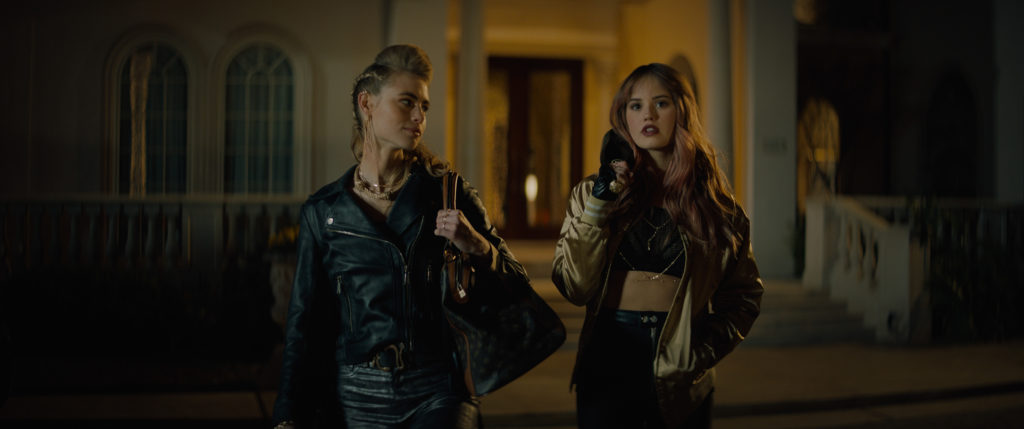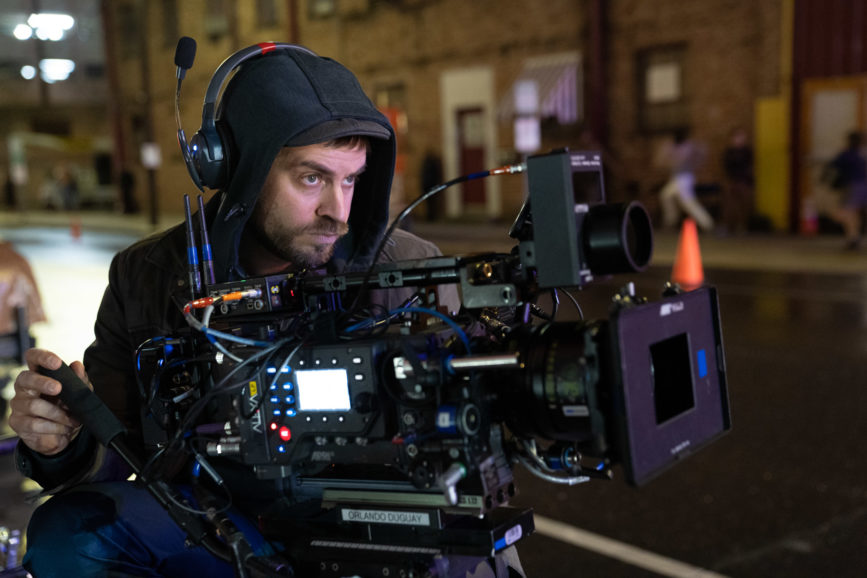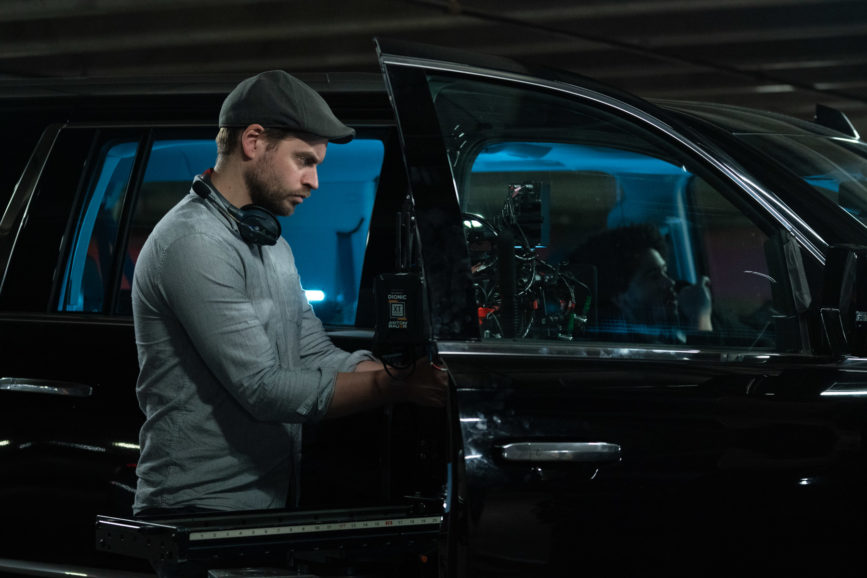DARK ADVENTURE
An ambitious production team crafted their own version of Los Angeles when filming vampire thriller Night Teeth. Eben Bolter BSC reveals how the approach adopted allowed them to be bigger, bolder, and more expressive when telling the story of a wild night out and the discovery of a dark underworld.
“At its core, this isn’t a horror, I see it more as an adventure film,” says Eben Bolter BSC, the cinematographer behind vampire thriller Night Teeth’s slick, neon-drenched visuals. The stylish Netflix production follows the antics that unfold over one night when Benny, a student moonlighting as a chauffeur, picks up two mysterious women in his car. During the wild night of party-hopping across LA, his passengers’ bloodthirsty intentions and dangerous underworld are revealed.
Bolter first worked with Night Teeth director Adam Randall when they collaborated on thriller Level Up in 2016. “Although the film was set in London, we bonded over our love of Asian cinema and this influenced our approach as we tried to elevate the production by introducing more colour and vibrancy,” says Bolter.

A similar methodology was adopted for Night Teeth. “As it was a Netflix production, the available budget gave us the opportunity to do more, so we took the core concept of the vampire tale and located it in LA – a great position because we had the beach and it was easy to incorporate neon lights, and colour,” says Bolter.
The filmmakers took the concept further, creating a world inside a world and examining what might happen if Los Angeles was even more colourful and exciting. Research involved examining how LA had been captured in films such as Drive (2011) and observing the use of colour in productions including action thriller Thief (1981) and 2019 series Euphoria. “Stylistically, I split Night Teeth in two. While it has a neon-noir aesthetic, at its core we kept it almost like an ‘80s adventure movie. On the camera side, I wanted to pay homage to films such as The Goonies and Raiders of the Lost Ark. I wanted it to be anamorphic with an element of vintage to the lenses. For lighting inspiration, I looked at more recent productions such as Euphoria.”

Six weeks of shooting in New Orleans, which doubled for LA, preceded a three-week shoot in LA. The time in New Orleans allowed the crew to build more sets and craft their own version of Los Angeles. Working with production designer Jeremy Reed, they changed modern LED streetlights found in LA to warmer sodium vapour lights and incorporated giant billboards covered in green lights to wash the street in a green hue.
“We had the opportunity to be bigger, bolder, and more expressive. It’s a vampire movie, not a documentary, so nobody would question the logic,” adds Bolter. “It also helped that Adam is a director who thinks very visually and loves shot making and bold lighting. He has high expectations for cinematography which makes me a better DP.”


Structured shot making
Randall and Bolter plan and shoot in a very structured way, extensively verbally storyboarding in prep. “We create shots, not scenes, and discuss each one in such detail that we often don’t need to look at the list we’ve created as we just know how we’ll shoot each sequence.”
From the initial five-hour script discussion, which saw Randall and Bolter analyse Night Teeth scene by scene at the BFI Southbank in London, the pair agreed the film they wanted to make would be incredibly colourful. “But we didn’t want to just arbitrarily throw any colour at it, we needed to adopt a thoughtful approach to the colour journey,” says Bolter. Once the “colour bible” had been created, decisions were made about how production design, costume design and other elements would work in unison.
Having already formed a robust working connection on previous productions, the person introduced to head up production design needed to understand the cinematographer and director’s ambitions for colour and each location. “Jeremy [Reed] was the perfect addition,” says Bolter. “He knows about architecture and has a great eye for detail, so he would embellish and elevate our colour and design ideas.”

While many interiors were set builds in New Orleans, sequences taking place in a night club were shot in a real club in the city. Being a cinematographer who regularly assigns locations a set colour to act as a visual bookmark, Bolter decided on a purple theme for the club, countered with a light blue. A large neon purple sign was erected outside the nightclub to wash the street in purple and the back alley was illuminated by purple lights. “Inside the club, we worked with the venue’s lighting mixer and used existing lighting rigs combined with our own fixtures, so we could incorporate all the moving lights of a club whilst controlling the colour to make it work on camera.”
The look was elevated further in the club’s VIP room. Bolter, who is a fan of using LED screens over blue or green screen and has explored virtual production techniques, suggested hanging an LED screen above the set to create an “animated ceiling”. “When Benny becomes intoxicated, we wanted to create a trippy feeling using a crazy ceiling effect which would contrast with some serious fighting action taking place on the other side of the room,” says Bolter.
The LED ceiling concept needed to be modified because the screens were too heavy to rig. Instead, two 20’ x 20’ projector screens were rigged above the set build, pulled as tightly as possible, and rear projected onto it to create the effect that the ceiling is moving. “What you see in camera is untouched and didn’t require any visual effects,” says Bolter. “The shiny black walls and floor were almost mirror-like which created some nice reflections.”

The car as a character
Benny’s car becomes a key character in the film as around a third of the action unfolds inside the vehicle. “What we see outside the car was really important,” says Bolter, “but however you shoot in cars, it’s always a pain. If you shoot in a studio, it looks fake and if you shoot on the road, you have no control.”
Aside from two journeys which were shot on location, all other in-car sequences were captured at Netflix’s NLAB studio in Los Angeles in a 14-LED screen ROE Visual BP 2.8mm background walls mixed reality environment. When the decision was made to shoot in this way, Bolter explored how others have approached Poor Man’s Process work when filming driving scenes. “I discovered that what I didn’t like about studio car work and what makes it look fake is that it is too steady, too perfect, and the lighting is too constant,” he says. “Real car work is always quite messy and bouncy, with imperfect lighting. There are mistakes, but they make it feel real.”

Bolter and Randall wanted to use the best screens and not compromise on the quality of the plates. Crew members shot a vast number of streets around LA with 16 cameras, compiling a total of 30 hours of footage. “An incredible team at the studio also helped ensure the screens looked their best on camera. We used the screens to light the actors too,” says Bolter. “To make it look more realistic, we made sure there were bumps and shakes when they were in the car. Any time it felt like an actor was too perfectly lit, we mixed it up. The crazy thing was that real LA was outside our studio, yet we were pretending we’re in LA on the screens! But that approach allowed us to be more creative with camera angles and achieve good continuity, so I think it was the right choice.”
The most challenging sequence, again centring on the vehicle, was one of the final scenes which sees the car smash through glass as sunlight bursts through. Randall wanted this to be captured at incredibly high speed, shooting with the Phantom at 2,000 frames per second. “I had to light the room in a way that felt like it was daylight outside, but that there was a magical, filtered glass cutting the sunlight out to protect the vampires,” says Bolter. “That had to visually make sense and still read like daylight outside. We didn’t want the audience questioning why it was daylight one minute and then night-time inside the next.”

Blade Runner (1982) was a valuable reference, specifically the scene where Rachael and Deckard first meet, and a digital sunblind comes down, creating a warm, surreal effect. “We wanted to achieve a similar look in our living room before the windows break and the strong beams of light shine through,” he adds.
As the art department needed to build the windows in as an integral part of the set, Bolter was not able to light the set without them there. “I knew we’d need to work backwards from the shot of the car smashing through, so I had to be able to show the room in its dark state and then for it to look completely different when the sun bursts through, but all shot at the same frame rate of 2,000 frames per second.”
To achieve this, Bolter lit the dark room incredibly brightly so that it would hold at 2,000 frames per second and then worked out how dark the glass should be and how bright the sun should be, so that when the glass breaks, the sun is bright, but not overexposing. “The really nerve-wracking part was that if it went wrong, it would have taken three days to reset everything. As we were shooting in mid-March 2020, four days before the COVID shutdown, we wouldn’t have had enough time. We had seven cameras and a couple of Phantoms on that scene and thankfully captured everything successfully at once.”
New approaches to capturing action
Camera package selection was partly motivated by an approach the filmmakers wanted to adopt to capture action scenes. John Wick was an influence in terms of style, the use of neon, and fight sequences, but Bolter and Randall knew “they couldn’t compete with the movie’s exceptional action scenes”. “Instead, we emphasised the fact that Benny is a fish out of water and an everyman rather than an action star, so we decided to experience the action from his perspective,” says Bolter. “In the scene in the club, we thought it would be fun to shoot an inebriated Benny in a medium close-up, completely oblivious to the crazy fight sequence taking place over his shoulder. We thought there was some comedy in that strange way of staging a fight scene.”
Having used ARRI cameras almost exclusively for the past 10 years, Bolter explored the available options with Simon Surtees at ARRI Rental, with the approach to framing action scenes such as the club sequence in mind. “We considered the Alexa 65, which I’d used before, but we needed a smaller camera that we could throw around more and allowed us to be nimbler,” says Bolter.

Surtees suggested Bolter use the Alexa Mini LF with the brand-new Caldwell Chameleon large format anamorphic lenses. “The Chameleons had a great colour and good contrast in the middle which then fell away at the edges,” says Bolter. “We loved the look of the Super 35+ version of the lenses as the true large format version was too clean for us.”
When testing the 50mm large format lens, Bolter discovered it offered a similar angle of view to a 21mm spherical. But instead of distorting the actor’s face whilst creating a wide-open world behind them when shooting a close-up, the shot of Benny did not appear distorted when using the Chameleon lenses on a large-format camera.
“The large format combined with the fact they are T2 anamorphic lenses, meant we could be really open wide and knock the focus out, producing a unique image that made it all about Benny, but still showing the action behind,” says Bolter. “As soon as we saw it, we said, ‘That’s the film, right there.’”


Camera movement always needed to be motivated and tell a story. “At the same time, we wanted it to be bold and fun, so we weren’t afraid to spin the camera and push in or be a bit gratuitous,” says Bolter. “We love developing a scene through shots that are blended together using Steadicam, so we might start on a close-up of a coffee cup, focus on Benny and then as someone walks past, we transfer onto them and then end in a two shot.”
Night Teeth is peppered with crane shots, but one in particular stands out as being particularly ambitious. “Benny is waiting at a stoplight and then there is a POV shot of a car rushing through the town before it takes a sharp turn and lands really close to Benny’s face,” says Bolter. “To achieve that we used the Russian arm, and the shot is in reverse. So, we started with the camera almost touching the windscreen outside the car, and then it sped away in reverse and was tilted down towards the floor.
This technically impressive shot was only achievable with the help of Bolter’s incredible operators – A cam/Steadicam operator Orlando Duguay was his New Orleans operator and Neil Bryan was his operator in LA. Neil also captured the film’s aerial sequences, using the Sony Venice in the helicopter for night work due to its high ISO and the Alexa Mini LF when he flew a drone. Bolter elaborates: “I used to be a DP who insisted on operating but I’ve discovered it is much better for me to work with talented operators such as Orlando and Neil, so I can sit at the monitor with the director and really clearly see what we’re doing and think about every aspect of the cinematography.”

Motivated by colour
Having appreciated the work of Company 3 colourist, Jill Bogdanowicz on films such as Joker and John Wick, Bolter was elated when she came on board to help craft the world of Night Teeth. “We were so lucky to secure her for the project – Jill knows how to achieve the grainy neon look we were aiming for better than anyone.”
After discussing a collection of films that adopted a similar style and the main goals for Night Teeth, Bogdanowicz created three LUTs which Bolter tested and compared on set before deciding on one LUT for the whole film. “That put us in a strong position as the image that the producers saw on the monitors was a good indication of what the finished film would look like, which was later fine-tuned in the grade. That prep with Jill and the LUT she developed was crucial.”

Monitoring in HDR was also beneficial. Bolter had previously shot five productions in HDR but always monitored on set in SDR, coloured in SDR and then carried out an HDR translation. With Night Teeth being a Netflix production which would be viewed by many on HDR televisions, Bolter felt monitoring in HDR would be helpful. “Netflix were really supportive and got us a 32-inch Flanders Scientific HDR monitor and thanks to Jill and Company 3’s expertise, we had an SDR and HDR LUT. And with the help of my brilliant DITs in New Orleans [Brian Stegeman] and LA [Chris Hoyle], we had an SDR and an HDR monitor side by side, so when I was lighting, I could really see the difference firsthand.”
When working in HDR, Bolter’s philosophy is to make it look rich, colourful, and cinematic but to “keep a lid on the extreme end of HDR”. “We decided to have a 70% cap on our highlights, unless it was for a special effect. We saved the top end of HDR brightness for the sun bursting through when the car smashes the glass, for example, because that’s when we want the audience to squint, because that’s what the characters are doing.”

Colour was at the forefront when exploring lighting approaches with gaffer Nathan Tape. “We knew LED was going to play a big part so we decided early on that we would need tonnes of SkyPanels, Asteras, and LED ribbon,” says Bolter. “As the car is so important and the characters would be inside it for 30 pages of the script, we really considered how best to light it, deciding that as it is a chauffeur service it could feature cool integrated lighting.”
Tape incorporated LED strip lighting either side of the car interior and then Bolter carried out tests to achieve his chosen cyan and green hues. “We always wanted to incorporate a splash of colour from somewhere and never wanted somebody to be lit just by one clean source. If we ever lit an environment and an actor looked too neutral, we added something. Nathan was great at keeping on top of that – he had a real eye for considered lighting.”

Night Teeth marked British cinematographer Bolter’s first union studio movie in America, an experience he refers to as “a dream come true”. “It was really inspiring for the future, and I can’t wait to make another film in America soon,” he says.
The process of shooting a film in line with pandemic protocols was a learning curve that brought with it some constructive lessons for the team. “There was a lot of safety in place which made shooting slower, but it gave us more time to consider our approach,” says Bolter. “I think the recent call for strike action in the US partly came about because everything is now starting to go back to how it was – longer hours and less time to think. The pandemic method of filming we adopted proved that you can make a film on a more generous schedule. If you are given more time, you can do great work safely. It was quite eye opening.”












